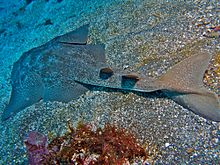Japanese angelshark
| Japanese angelshark | |
|---|---|

| |
| Scientific classification | |
| Domain: | Eukaryota |
| Kingdom: | Animalia |
| Phylum: | Chordata |
| Class: | Chondrichthyes |
| Subclass: | Elasmobranchii |
| Subdivision: | Selachimorpha |
| Order: | Squatiniformes |
| Family: | Squatinidae |
| Genus: | Squatina |
| Species: | S. japonica
|
| Binomial name | |
| Squatina japonica Bleeker, 1858
| |

| |
| Range of the Japanese angelshark[1] | |
The Japanese angelshark (Squatina japonica) is a
Feeding on
Taxonomy and phylogeny
The Japanese angelshark was described by Dutch
Using
Description

The Japanese angelshark is fairly narrow-bodied and has greatly enlarged
The frontmost portion of each pectoral fin forms a triangular lobe separate from the head. The outer corners of the pectoral fins are angular, and their rear tips are rounded. The pelvic fins have convex margins. The two angular
Distribution and habitat
The Japanese angelshark is native to the cooler waters of the northwestern Pacific; its range extends from the eastern coast of
Biology and ecology

During the day, the Japanese angelshark mostly lies partly buried on the bottom; its complex color pattern provides
Human interactions
The Japanese angelshark is typically inoffensive towards humans, but if disturbed, can inflict a severe bite. Across much of its range, it is a frequent catch (intentional or not) in
Angel sharks in general are highly threatened by
References
- ^ . Retrieved 19 November 2021.
- ^ Bleeker, P. (1858). "Vierde bijdrage tot de kennis der icthyologische fauna van Japan". Acta Societatis Scientiarum Indo-Neerlandicae. 3 (art. 10): 1–46.
- ^ ISBN 978-92-5-101384-7.
- ^ Froese, R.; Pauly, D., eds. (2011). "Squatina japonica, Japanese angelshark". FishBase. Retrieved June 16, 2013.
- PMID 19647086.
- ^ .
- ^ ISBN 978-0-930118-18-1.
- .
- ISBN 978-1-55209-629-1.
- ^ Yamaguti, S. (1934). "Studies on the Helminth fauna of Japan. Part 4. Cestodes of fishes". Japanese Journal of Zoology. 6: 1–112.
- .
- PMID 9920318.
- S2CID 253745118.
External links

